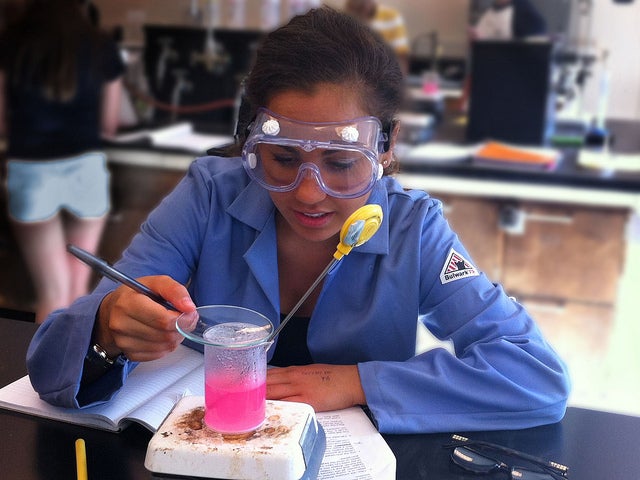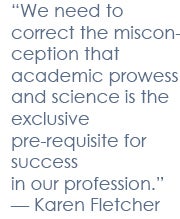
(Photo Credit: Isabelle Saldana via Flickr)
Experts say that almost all of the 30 fastest-growing occupations in the next decade will require at least some background in STEM — science, technology, engineering, and math. As chief engineer at DuPont, I see all four of those disciplines working tightly together to translate cutting-edge science into innovative solutions to some of the world’s most pressing challenges. So it is concerning to me that the percentage of US university graduates who earn engineering degrees — both men and women — is just 4.5 percent compared with 12.5 percent in Europe and 21 percent in Asia.
I’m not the only one concerned. I recently participated in a panel convened by the Aspen Institute, the Association for Women in Science, and the Bertelsmann Foundation to address the fact that women make up only one-quarter of the advanced manufacturing workforce. Even more concerning, their representation on the shop floor is shrinking and their presence among leadership remains low. I exchanged views with other female leaders about why this matters, and more important, what we can do to turn the tide.
 Investment in our nation’s talent pipeline must be a collaborative effort that includes academia, government, industry, and professional societies, among others. I believe engineers themselves must lead the charge in helping society understand how engineers make a difference and why our profession is rewarding; acknowledging the skills that are required for success; and fostering a sense of community that attracts and retains the talent we need for the future.
Investment in our nation’s talent pipeline must be a collaborative effort that includes academia, government, industry, and professional societies, among others. I believe engineers themselves must lead the charge in helping society understand how engineers make a difference and why our profession is rewarding; acknowledging the skills that are required for success; and fostering a sense of community that attracts and retains the talent we need for the future.
I was encouraged to pursue engineering because my high school guidance counselor knew I excelled in math and science. But that approach sells our profession short. Research suggests that K-12 teachers and students generally have a poor understanding of what engineers do. This is echoed at the university level. For example, a 2008 report by the National Academy of Engineering found that when first-year students were asked why they do not choose to study engineering, the overwhelming reply is that they prefer a discipline that will empower them to help others and make the world a better place. Contrast this with the fact that engineers at DuPont are working on tremendous challenges that affect the world’s population, such as decreasing our dependence on fossil fuels, finding nutritious ways to feed expanding populations, and providing better protection for people and the environment. We have to help young people connect engineers with the things that matter to them.
We need to correct the misconception that academic prowess in math and science is the exclusive pre-requisite for success in our profession. In a recent survey at DuPont, early-career engineers reported that society views engineers as anti-social and unimaginative, but the top three words they used to describe themselves were “creative,” “collaborative,” and “problem-solvers.” These words embody the characteristics of engineers that companies like DuPont want to hire. I view technical competency as table stakes. It is a starting point, but not enough by itself.
The challenges facing our workforce are of increasing scale and complexity, making it necessary for people to work across organizational boundaries and disciplines. We need employees who can collaborate effectively and apply creativity in solving the challenges before us. In addition to encouraging academic institutions to help foster these skills, engineering professionals can volunteer their time working with young people in STEM-focused activities such as Lego leagues and robotics competitions, and through programs like DiscoverE’s “Future Cities” competition. These activities bring diverse young people together and require them to collaborate while creatively applying technical skills to a variety of challenges. They’re also powerful opportunities to send a clear and personal message about how engineers make a difference in real life.
I believe that attracting and retaining a diverse pipeline of engineering talent requires fostering personal connections. This is especially important because diversity within the US engineering population fails to mirror that of our overall workforce. According to a recent analysis from the nonprofit organization Change the Equation, African Americans and Hispanics comprise one-third of the college-aged population, yet together they earn less than 16 percent of all engineering degrees and certificates.
And diversity means much more than race and gender. For example, there is diversity in career history and experience. How can we foster networks of people within and across our companies so that we are inspiring and supporting each other? How can successful engineers encourage others to follow in their footsteps and transfer knowledge to the next generation of engineers in meaningful ways? One of the best hours I spent in the last month was with an informal network of my female colleagues, in which we had a rich dialogue between early-career engineers and more senior women who provided perspective on navigating their careers and shared “the best advice I ever got.” The sense of community in the room was palpable, and we can do more to extend that feeling of connectedness from the factory floor to the corner office.
To inspire a diverse and sustainable pipeline of future talent, engineers must help others to understand the impact we have on society and to feel a connection to the people behind the profession. Together we can communicate the requisites and rewards of being part of a community of problem-solvers who are making our world a better place.
Karen A. Fletcher is vice president of DuPont Engineering and chief engineer.
RELATED CONTENT:

